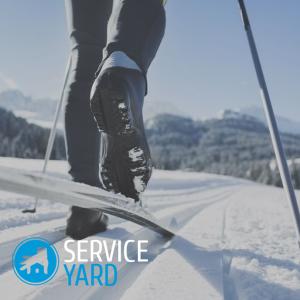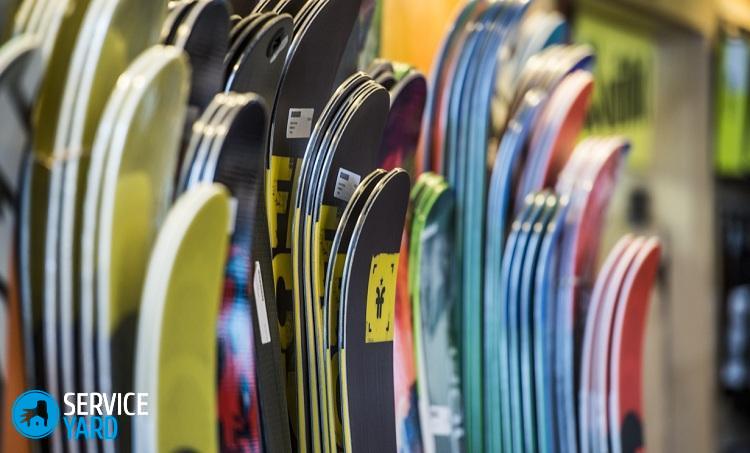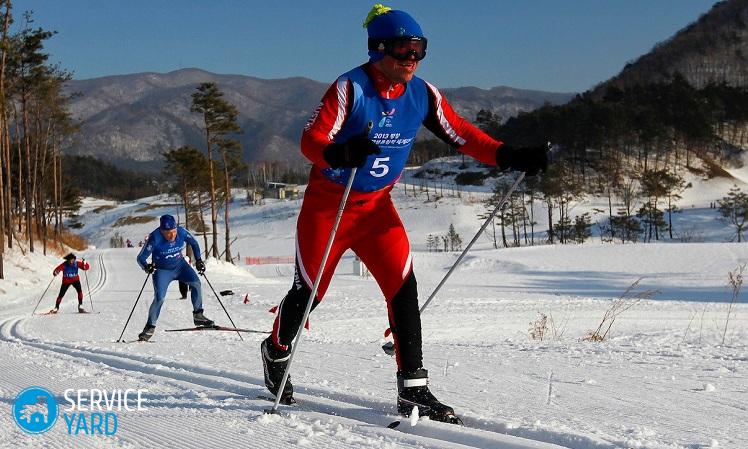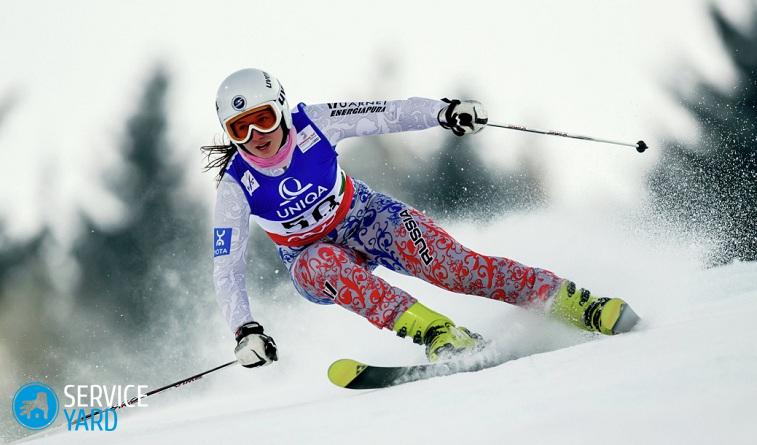Selection of skis by height and weight - table

To pick up a pair of skis that will completely suit the skier is a task with an asterisk. Here it is necessary to take into account many parameters: the area where the skis will be used, the level of training, the style of skiing, where the selection of skates plays an important role. Of course, the table will always help to make the right selection of skis for height and weight, but besides this, there are still a lot of nuances. In this article, we will consider the main parameters for selecting skis from anthropometric human data.
to contents ↑Ski types
To begin, consider what types of skis are and their main characteristics.
Racing
Racing skiing (RACING) is intended for athletes who participate in cross-country skiing and other similar sports: winter all-around, biathlon, ski orienteering.
They differ:
- Special dynamic characteristics - the weight distribution of the athlete along the length of the ski, rigidity.
- Low weight.
- A special type of sliding surface that provides the best quality of sliding under different weather conditions.
Important! Racing sports equipment is divided into equipment for classic and skating. Moreover, the differences between these species are so significant that they can only be used for their intended purpose.
On cross-country skiing, you can only ride on specially prepared tracks - they are not intended for movement on soft ski tracks or loose snow.
Important! In this category, the elite equipment RACING PRO - expensive models for professional racers and RACING sports skiing - relatively inexpensive models for amateur racers are distinguished.
Walking
Walking views (RECREATION category) are intended for lovers of skiing. This is the most popular category of consumers; therefore, such models have a relatively low price and are considered universal. You can ride on them both classic and skating, along the ski track and on prepared tracks.
Important! Such skis are a bit heavier and wider in comparison with racing, but they are more stable, and the novice athlete will feel more confident on them.
FITNESS models should also be considered as walking options. They are intended for those who do not seek to take part in competitions, but want to keep their body in good shape with the help of active exercises. Such equipment is made using high quality materials and advanced technologies, so their price level is about the same as for racing models.
For tourism
Models for extreme tourism (BACK COUNTRY) are intended for lovers of skiing in conditions where there are no ski and walking trails. They are wide enough to allow them to easily navigate the virgin snow, and are characterized by special strength.
Important! These are relatively expensive models that have passed a number of tests for reliability, since the success of an expedition or a trip, and sometimes the health and life of a person who defies the wild, depends on their quality.
For children and teenagers
Among the KID / JUNIOR models that are designed for children and adolescents, one can find sports that are close in quality to racing models, as well as fairly inexpensive walking sports equipment, including equipment for children aged 3-8 years, taking their first steps on the track.
to contents ↑Important! Before choosing skis by weight, determine your goals, evaluate your abilities and needs. Depending on how correctly you choose a ski model, each walk on them can become a real curse and incomparable pleasure.
How to choose skis according to weight and height?
If you opted for one of the ski models, then when you come to the store, you will also need to choose them according to your height and weight.
Growth Matching
The rules for choosing equipment in length are different for ridge and classic models, so some points should be kept in mind:
- Skate models should be about 10-15 cm longer than the skier.
- The recommended length of the models for the classic course is considered to be 25-30 cm longer than the height of the skier.
- Walking sports equipment should be selected in the range of 15-25 cm more than their height.
- When choosing walking equipment for skiers with a relatively large weight, it is advisable to adhere to the upper limit of the range, and with a relatively small weight - to the lower limit.
Important! Novice skiers need to remember that short models are easier to manage, so it’s easier to learn how to ride them at first. Confident skiers can pick up options more authenticly, because longer models provide better gliding.
Weight matching
In order to select skis by weight, it is necessary to determine their stiffness. The rigidity of the equipment can be selected using a special meter - flex tester. They determine it on a flat surface or a specially designed board for measuring the stiffness of skis. And if you have enough experience, you can pre-evaluate stiffness by simply squeezing a couple with your hands.
Important! The flex tester is a special device for selecting skis for stiffness according to the weight of the skier. The sellers-consultants of specialized stores should help to choose equipment with this device.
The selection procedure using the flex tester is as follows:
- Fix a pair of skis in the clamp and make an effort equal to half the weight of your body (taking into account the weight of the shoes and clothes), focusing on the dynamometer.
Important! Make sure that there is a significant gap between the skis (at least 40-50 cm in length and 1-2 cm in height). If the gap is less, then you should choose a stiffer pair.
- Next, increase the clamping force to a value that is equal to the weight of your body. At the same time, the free gap under the block between the skis should decrease in length to 10-15 cm in racing species, and in recreational ones it should completely disappear.
to contents ↑Important! If the gap is too large, it is advisable to pick up a pair softer.
Alpine ski selection
To choose the right model, you need to know about some tips and tricks. Let's take a closer look at them.
For the classic move
It is necessary to select the mountain model for the classic course very carefully, because it will depend on how much you can ride:
- When choosing, you must take into account your weight, weather conditions under which the equipment will be used, the strength of the leg push, and, of course, personal preferences.
- As a rule, skis for cold weather are chosen more elastic and softer than models for positive weather. In the cold, there is no need to apply thick layers of ointment, and this makes it possible to take a softer pair. And at positive temperature, the thickness of the applied ointment layer is much larger, and the rigidity of the ski should be higher so that the deflection compensates for the difference in the thickness of the ointment layer, especially when using soil and liquid lubricants.
- Athletes of a higher level, who have a powerful push, it is advisable to choose a model a little tougher. On such a pair, a skier can do a long rental without contact of the holding area with snow. For less trained people, it is advisable to choose softer models that make it easier to get a reliable “hold” of grease.
- If you choose a pair of classic type, then the length of the skis should exceed your height by about 25-30 cm. And the sticks - on the contrary, you need to pick up about 23-30 cm less than height. Although if you have excellent physical fitness and want to increase the load, you can buy more authentic products.
For skating
Skating skis are called due to the fact that when moving on them, the skier uses the same running technique as the skater. To do this, it is repelled from the snow surface by the inside of the ski, while transferring all its weight to a sliding ski, and vice versa.
Important! It is worth noting that the skate course is more appropriate for those who have a well-trained body and arms.
Here are some things to keep in mind that skating is right:
- Skis of this type are shorter in length than classic skis - their maximum length can be no more than 192 cm. During riding on such a pair, an athlete should not touch the surface of the middle part of the ski. Therefore, such models should be more rigid in comparison with the classical ones.
Important! If you intend to use them only for walking, it is better to choose softer and more elastic products that make it easier to maintain balance.
- In order to select skates for height and weight, you need to remember the following: they should be about 15 cm more than the height of the skier, and sticks - 15 cm less.
Selection of combined models
This type can be used both for classic and for skating:
- The maximum length of the combined types is 200 cm. However, to use different riding styles it is better to choose a pair with a length of not more than 192 cm - in this case, with the ridge, the heels will not hurt each other.
- The design of such skis is more reminiscent of classic models, but it is recommended to determine their length a little differently. Combined skis should be about 20 cm more than the athlete's height, and poles for them are better to choose shorter by 20 cm.
Stock footage
When choosing skis for height and weight, the manufacturer of sports equipment should also be considered. Cheap analogues will have worse traction on a snowy surface, so it is better to give preference to companies that have established themselves in this industry from the best side. Before buying, it is advisable to ride on an attractive model, since in this matter everything is very individual and depends on height, weight, level of physical activity and fitness.
- How to choose a vacuum cleaner taking into account the characteristics of the house and coatings?
- What to look for when choosing a water delivery
- How to quickly create comfort at home - tips for housewives
- How to choose the perfect TV - useful tips
- What to look for when choosing blinds
- What should be running shoes?
- What useful things can you buy in a hardware store
- Iphone 11 pro max review
- Than iPhone is better than Android smartphones






